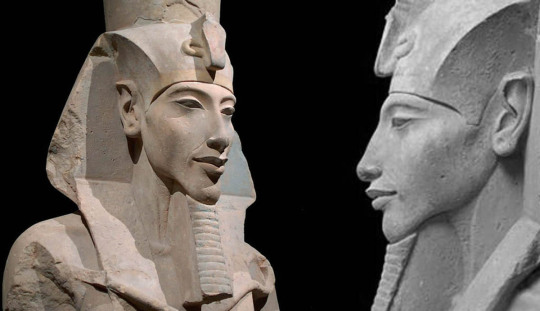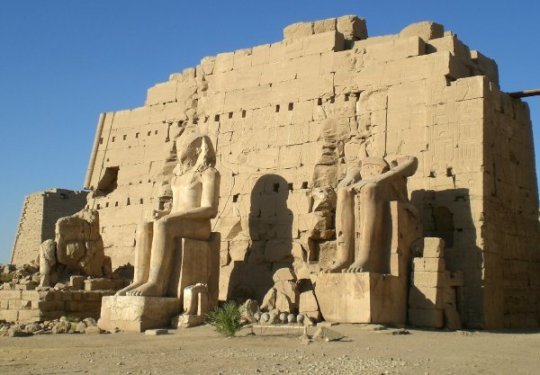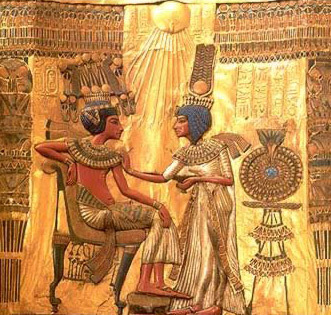#i suffered copying the show style instead of doing my own thing bc i wanted it to look believable
Text


I wanted to see him shirtless so i edited the screenshot. And also his knife holster thing while shirtless.
#jujutsu kaisen#jjk#nanami kento#kento nanami#jjk edit#i suffered copying the show style instead of doing my own thing bc i wanted it to look believable
373 notes
·
View notes
Text
Akhenaten

The name Akhenaten is rather well known as a Pharaoh of Egypt. Like Ramesses II, Hatshepsut, Cleopatra, and Tutankhamun, Akhenaten won the popularity contest of modern society through defining himself as far different from most other Pharaohs. With Akhenaten, however, he’s not even like the special Pharaohs.
Let’s look a little at his life and the history of the time period he ruled over. He was in the 18th Dynasty of the New Kingdom, from 1353-1336 BC. Like most Pharaohs there are a few different pronunciations of his name, including Akhenaton, Ikhnaton, Khuenaten, all meaning of great use to Aten, which leads into his conversion into the cult of Aten. Before the conversion his name was Amenhotep IV, son of Amenhotep III. His mother was named Tiye. Later on in life he married Queen Nefertiti, fathering two children, one from his wife Nefertiti and one from his lesser wife, Lady Kiya, having Ahnksenamun and Tutankhamun to each wife respectively.
Before we get into the whole mess of his religion and the ‘revamping’ he did of ancient Egypt, let’s recognize the other things he did for or to the country.
You’ll recognize the vastly different art style between Akhenaten’s rule and the history of most of Egypt. In art that depicts Akhenaten, he was shown as long and spindly, a style that carried into his family. Some people believe that this was because he and his family suffered from Marfan’s syndrome, a disease that caused the elongation of bones and skinniness. A more likely explanation stems from the Pharaoh’s religious beliefs, which as you know, was vastly different from other Pharaohs. This theory is a little more likely because there was no reason for the queen Nefertiti to have the same condition as her husband. Instead, it was probably because their status was far different from the other Pharaohs, as they were moved into a genuinely god-like status for their worship of Aten.
The part of Akhenaten and his rule that interests me the most is the way the royal family was presented in art, despite the style. Like many parts of Akhenaten, it’s entirely different from other Pharaohs (though, whether that’s good or bad is up to you).
Now, most Pharaohs presented themselves highly in art. They could do that, so why not? If I had the guts and the money I probably would too, but my point is that essentially all Pharaohs depicted themselves alone on stelas, engaging in hunting or other activities that strengthened the image of themselves that they wanted to show the world. Usually they were masculine tasks that could be done only by those with great strength and great riches. Akhenaten went in an entirely different direction; he depicted himself with his family. In the stele of Akhenaten, he is shown in a private way, the scene being him with his family, enjoying themselves together.
While we can’t say the definitive reason for him presenting himself as this, the most logical conclusion has to do with, again, his religious beliefs. In his mind, the Aten was held above all else, even the Pharaoh. With Aten as the highest consideration, the Pharaoh and his family enjoyed their lives under the influence of the Aten’s love and grace.

Now that we have a little insight, let’s get into the whole mess of his religion that died immediately after he did.
Akhenaten originally reigned as Amenhotep IV, a reign that lasted around five years before he switched religions. Changing his name, he converted to a cult that worshipped Amun to that of Aten, abolishing the ancient rites of those before him, and instituting what is believed as the first example of monotheism state religion in the world. His rule as Akhenaten lasted 12 years, during which he was labelled as the infamous ‘heretic king’, so that should give you some insight into how people felt about him.
Before his rule, the cult of aten was a cult like all others in Egypt. It was a bit like choosing your favorite God – find the one you like most, and join that cult. For example if I were to join a cult, I would join the cult of my favorite God, Ma’at. I mention this because before the change, the Aten was shown in inscriptions of Akhenaten (Amenhotep IV at that point), represented by the sun disk. It’s also important to note cult doesn’t carry the same meaning as it did then, and each cult shared the same goal: balance and eternal harmony.
At the time of Amenhotep IV’s rule the Amun cult (where the Aten is from) held incredible power. Their power had been growing for a long while, and by the time of his rule, they held nearly as much power and riches as the Pharaoh himself, and actually owned more land than Amenhotep IV. The fifth year of his reign he switched everything; this was when he abolished the practices of the previous religion of Egypt, and proclaimed himself the “living incarnation of a single all-powerful deity known as Aten,” (Joshua J Mark), and by the ninth year, he closed every single temple, prohibiting all the old practices and devotion to the many Gods the people of Egypt worshipped.
Around then was when he moved the royal seat of Egypt from the traditional house of Thebes to a city of his own creation, a city named Akhetaten, and with that he changed his name to Akhenaten. Here he earned the name the Heretic King, earning the ire of some historians and the admiration of others.
Despite the fact that Akhenaten’s influence completely destroyed worship of the Gods many Egyptians loved, one of the main problems with his rule was that the Old Gods of Egypt instilled harmony and order in the citizens, ultimately helping to create a country that lasted over 4,000 years. Without these Gods, things got a little wonky.
Religious tolerance was allowed with the many Gods, emphasizing peace to the point where religious intolerance wasn’t even an issue. Unfortunately, for monotheism to work, there has to be something inherently wrong with the other side, which made Akhenaten’s work a lot harder, and its’ effects much stronger. It led to the intolerance of other beliefs and some severe suppression, and if you look at the monotheistic religions of today, you can see the same sort of pattern. With intolerance comes hatred and war.
“Dating to this point in Akhenaten’s reign was a campaign to excise the name of gods other than the Aten, especially Amun, from the monuments of Egypt. This was done with violence: hieroglyphs were brutally hacked from the walls of temples and tombs. This was probably carried out, at least in part, by illiterate iconoclasts, presumably following the orders of their king. [Akhenaten] carried out a religious revolution the like of which had never been seen before in Egypt.” (Zahi Hawass, 42-43).
There were priests of Atum who attempted to hide religious artifacts, storing statuary and texts away from the soldiers ordered to destroy them. The priests, with nothing left to do, were forced to abandon their temples. In response Akhenaten either hired new priests or forced the other ones to obey him, proclaiming him and his wife once more as Gods on earth.

Now you can see how Akhenaten kind of sucks. Let’s talk about how he sucks even more.
His foreign policy.
With his ego inflated to the size of the sun, Akhenaten thought himself above interactions with foreign powers. He left his duties to spend more time on himself and his family, ultimately leading to a severe neglect.
You might be asking, “didn’t every Pharaoh have a super-inflated ego?” and yes, you’d be right, but no Pharaoh before Akhenaten had genuinely claimed themselves to be a God. As a self-proclaimed incarnated God, he must’ve thought such affairs beneath him.
Discovered through letters of the time, several (former) allies of Egypt had asked for their help several times with various affairs. At the time Egypt was wealthy, prosperous, and strong, a state that had been slowly growing before halting at Queen Hatshepsut’s reign. Hatshepsut and her successors employed a strategy of actually doing work, by working out when to approach with diplomacy, and when military action was required. Akhenaten on the other hand, ignored everything outside of his palace at Akhetaten.
The uncertainty of Akhenaten’s rule, along with letters of correspondence between the city of Amarna, the Pharaoh, and foreign nations, led to this era being called the Amarna period. These very letters were proof of the Pharaoh’s negligence. However, the letters also show his keen eye in foreign diplomacy, if the situation interested him so. It was a whole thing with the Hittites, but since this is chiefly about Akhenaten, I’ll leave that topic for later. All you really need to know is that he only tended to issues that affected him directly, and through the Amarna letters, historians can see how poor of a King he was, as well as how deeply many of his subjects disliked or despised him.

Essentially, the main reason this mess didn’t work out was because it brought about something new: exclusivity. And the Egyptians did not like that, believing that the world needed to have a balance in order to stay away from slipping into chaos. In the end monotheism didn’t last; hell, it was ended basically the second Akhenaten’s son took the throne. Tutankhamun, originally named Tutankhaten, changed his name to reflect the return to polytheism. His successors tore down the reminders of Akhenaten’s reign, removing him and his adoration for the Aten, eradicating his name from the record.
There’s no saying he didn’t affect the world – he did, a lot. Whether that affect was good or bad is up to the interpreter (personally I don’t like it all that much). By Freud’s thinking (hear me out, I know he sucks) Akhenaten’s rule inspired the ancient world, leading others to copy his ideas and theology, eventually snowballing into our modern world, where there are essentially no polytheistic religions. You have to give him credit – he was the first person of the ancient world to dream up monotheism, changing what had defined humanity for so long.
With his name stricken from the books, historians only discovered him upon finding his city Akhetaten. In the records, Horemheb is labelled as Amenhotep III’s successor, skipping over both Akhenaten and Tutankhamun’s rule. Later when Tutankhamun’s tomb was found as one of the very few graves still filled with treasure, interest spiked in Tutankhamun’s life, eventually leading back to his father Akhenaten.
88 notes
·
View notes